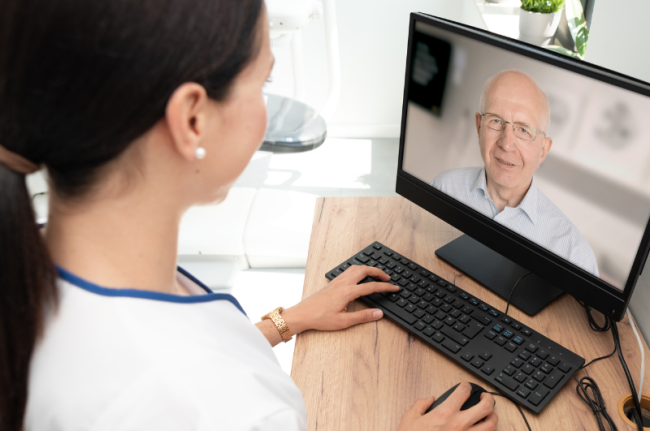Telehealth Beyond Covid: A Case for Continued Access
Across a wide variety of industries, the pandemic shined light on technology’s potential to keep people connected and productive while socially distanced. Telehealth, specifically, proved that virtual communication holds the power to revolutionize the way we approach the health and well-being of people at all stages of life. And while a return to more “normal” living no longer necessitates telehealth in all cases, its many benefits speak to why it should remain a permanent option for both patients and providers.
Most would agree that equal access to healthcare is a human right, not a privilege. But true access often depends on a patient’s location, financial status, and transportation. With gas prices rising, averaging around $5 a gallon in many parts of the country, travel continues to become more and more prohibitive. Moreover, the increasing costs of everyday essentials pose huge challenges for many families in America, many finding themselves facing very hard choices. A recent survey of 6,663 adults conducted by West Health and Gallup found that eight percent of adults cut back on paying for utilities to afford healthcare.
Logging on to a telehealth appointment from the comfort of the home provides a convenient, low-cost way for nearly anyone to see a doctor. This includes homebound patients, families in more rural/underserved areas, and those at the mercy of others/public transportation for rides to an office. Parents with young children can access after-hours care when middle-of-the-night ailments strike. And with telehealth, childcare is not an issue for working or single parents. Those with anxiety around doctor visits may even be more willing to seek help sooner through telehealth, possibly increasing the likelihood that they'll be treated earlier and more successfully.
El Camino Hospital in Mountain View, California illustrates exactly how telehealth is being used to improve healthcare for a variety of patients. El Camino Hospital CIO Deborah Muro explains, “…we deliver a lot of babies at El Camino Hospital…When a new mother needs a lactation consultant, it's likely she will need assistance at all hours of the day and night. We leverage virtual lactation services to meet the unique needs of these mothers.”
Muro goes on to say, “When a stroke patient comes into the ED, our team can connect with a neurologist who is not on site and diagnose the patient quickly at a time when minutes count," My advice is to think about all the opportunities where virtual care could address gaps in expertise or in resources. This will give you the flexibility to meet your community's needs as they arise."
Telehealth also offers numerous benefits for hospitals, doctors, and other providers. It empowers them to expand their patient bases, reduce operating costs, and better collaborate with multiple medical disciplines—sometimes increasing the pace of treatment times and therapies to further improve patient outcomes. These striking advantages will only continue to grow as more and more services, tools, devices, and apps designed to improve healthcare procedures continue to enter the market.
The Compassion Benefits of Telehealth for Aging, Critical, and Dying Patients
Over the last several years, pandemic restrictions on visitors to hospitals, nursing homes, and other medical settings exacerbated already heartbreaking situations for countless families of sick and dying patients. Without telehealth, many would have missed saying final goodbyes, adding to the unbearable pain of their losses. Being in the same room is always preferable during the most difficult times, but our global society means it isn’t always possible—Covid-19 aside. Telehealth as a regular option means that fewer people need die lonely deaths when family or friends are geographically scattered. For an aging population confined to home or nursing facilities, communicating virtually with family and friends is also a powerful way to combat isolation with conversation and other meaningful interactivity has proven to help keep the mind sharp. When loved ones cannot be at the bedside, compassionate nurses or caregivers assisting with simple virtual access can be the difference between lifelong regret and much-deserved comfort.
Whether for end-of-life visitation, virtual doctor visits, or sharing diagnostic information, telehealth continues to improve quality and access to healthcare for all in ways that we can all get (and stay) behind today and into the future. Read more about how Telehealth bridges the gap between healthcare providers and patients.
As telehealth technology continues to shape the way we communicate in a variety of healthcare settings, patient safety remains a top priority. TouchPoint Medical mobile telehealth carts, whether used for patient/doctor purposes or patient/loved one’s connection are constructed of antimicrobial materials with high touch surfaces that are infused, rather than topically applied, with antimicrobial properties to ensure long-term protection. When you select a cart with telehealth capabilities that is also cleaner by design, you can rest assured that it’s always working to retard the growth of surface bacteria. This gives peace of mind to caregivers knowing that they are protecting themselves and their patients.
The AccessPoint™ Workstation on Wheels combines telehealth with ergonomics in a way that helps reduce stress on both the healthcare provider and the HIT team. Read more about this WOW or schedule a demo with our team to learn more about the AccessPoint™ workstation.



